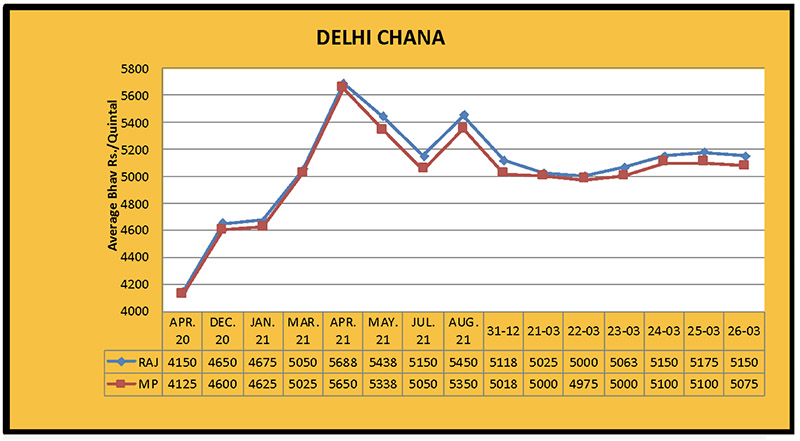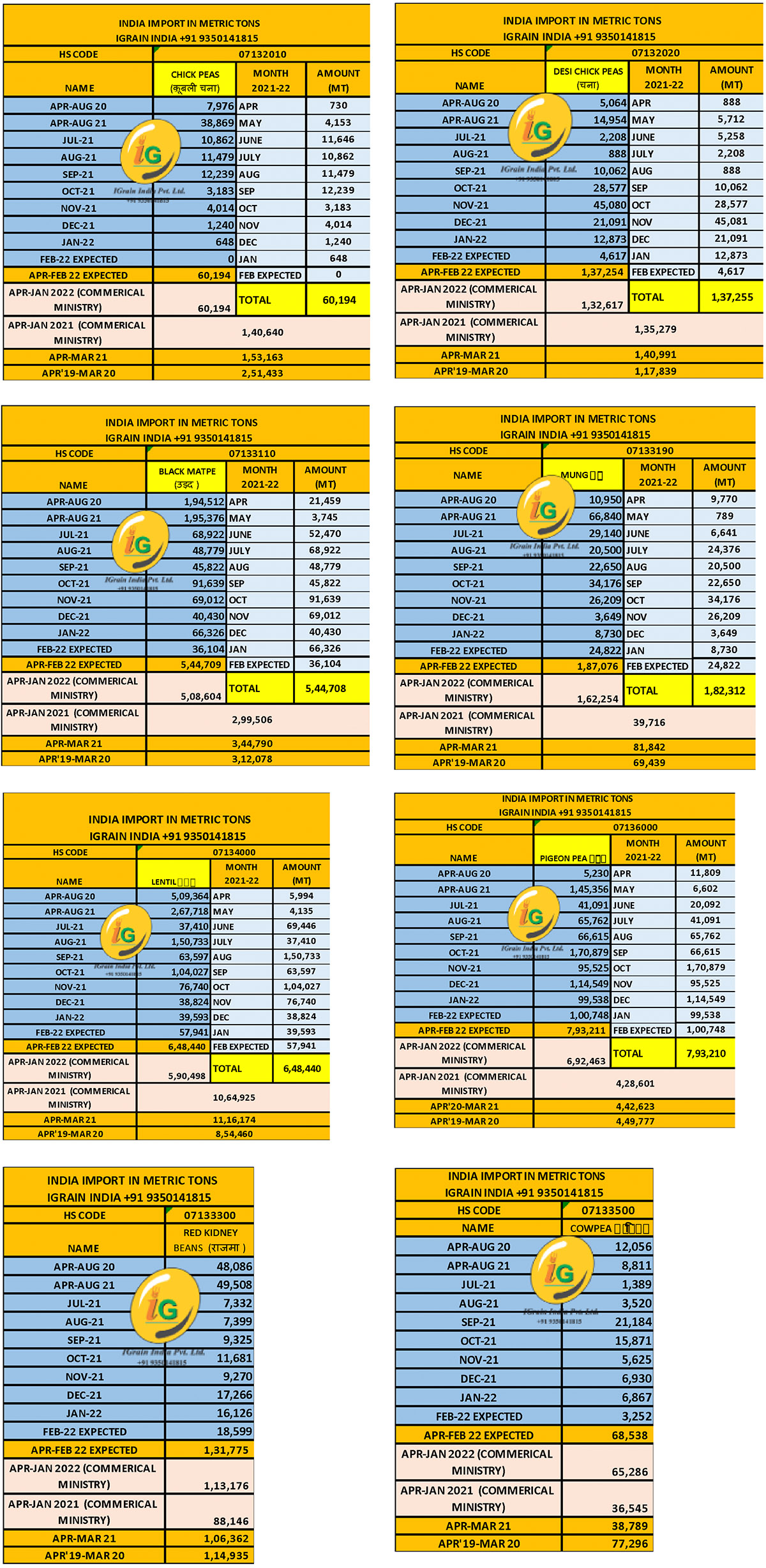
PRICES IMPROVED ON ACCOUNT OF GOOD DEMAND FROM MILLERS
New Delhi
Chana prices increased last week due to continued buying by stockists and millers. Delhi prices registered a rise of Rs. 50/75 per quintal and Rajasthan traded at Rs. 5,200 per quintal while Madhya Pradesh line reached Rs. 5,100 per quintal at the weekend.
Port
Buying in imported gram remained sluggish due to the increased availability of domestic goods in the market. Mumbai prices decreased by Rs. 25 per quintal and Tanzania prices fell to Rs. 4,575 per quintal over the weekend.
Rajasthan
Most of the mandis in Rajasthan remained closed this week due to the financial year closing. There was good, continued demand and Rajasthan prices registered a growth of Rs. 50/75 per quintal - with this improvement, Bikaner sold at Rs. 5100, Jaipur Rs. 5100, Jodhpur Rs. 4700/50, Kekri Rs. 4800 and Kishangarh Rs. 4700 per quintal.
Madhya Pradesh
Madhya Pradesh prices fell by Rs 50/75 per quintal due to weak buying on increased prices. By the weekend, Katni was selling at Rs. 5050/5100, Indore at Rs. 5100, Ashoknagar at Rs. 4800/4825 and Pipariya at Rs. 4700 /4900 per quintal.
Maharashtra
A slowdown in arrivals was seen in the mandis of Maharashtra. Due to this and improved buying, Maharashtra prices registered an increase of Rs 50/100 per quintal and by the weekend, Jalgaon sold at Rs. 4725/4975, Nagpur at Rs. 4950, Latur at Rs. 4700/4900, Akola at Rs. 4850/4875 and Udgir at Rs. 4550/4700 per quintal.
Karnataka
Due to weak demand, Karnataka prices saw a fall of Rs. 100/150 per quintal and Gulbarga sold at Rs. 4500/4711, Yadgir at Rs. 4212/4599, Hubli at Rs. 4001/4623, Bidar at Rs. 4400/4750 & Gadag at Rs. 4576/4917 per quintal.
Other
Raipur prices recorded an improvement of Rs. 25 per quintal, rising to Rs. 4950/5025 per quintal. In Kanpur, prices reduced by Rs. 25/50 per quintal, the Madhya Pradesh line fell to Rs. 5075 and Uttar Pradesh line to Rs. 5175 per quintal. Due to the March closing, the mandis of Gujarat remained closed.
Chana Dal
A bearish trend was seen due to a rise in chana prices. Chana Dal prices rose by Rs. 50/100 per quintal with Delhi prices reaching Rs. 5875/5950, Katni Rs. 6050, Latur Rs. 5950/6250, Gulbarga Rs. 5700/5850, Kanpur Rs. 5850/5900 and Indore Rs. 6000 per quintal.



Government procurement of gram started in Madhya Pradesh along with other states
Bhopal. The Central Government started procuring gram in Madhya Pradesh from March 23. Earlier, in states like Maharashtra, Gujarat, Andhra Pradesh and Telangana, gram was being procured from farmers at the Minimum Support Price (MSP). According to official sources, so far around 1000 tons of gram have been procured in Madhya Pradesh in the current Rabi marketing season of 2021-22 and this quantity is likely to increase rapidly in the coming days. Madhya Pradesh is traditionally the largest producer of gram in India. This year, an increase in the sown area and largely favorable weather conditions mean the overall production is expected to be better. The central government has fixed the MSP of chana at Rs 5,230 per quintal, compared to Rs 5100 per quintal last year. Wholesale prices are currently running below the MSP.
NAFED, a subordinate agency of the Union Agriculture Ministry, has set a target of purchasing 8.71 lakh tons of gram by May 31, 2022 in Madhya Pradesh. At present, the pace of procurement is a bit sluggish but the pace is expected to pick up from April. Chana is also being procured by NAFED in states such as Maharashtra, Gujarat, Karnataka, Andhra Pradesh and Telangana. By April 6, 2022, about 4.27 lakh tons of gram had been purchased by this agency at the national level. Government procurement of gram started from the first week of April in Rajasthan, another major producing state. A total government procurement target of 1.5 million tons of chickpeas has been set across the country during the entire marketing season and, considering the market conditions, if prices are below the MSP, procurement may reach 1.2 million tons.
The central government has estimated the domestic production of gram to reach a new record level of 13.12 million tons in the current season, compared to 11.91 million tons last season. The crop condition is quite normal in most of the states.
More than 3 lakh tons of pulses and pulses exported from the country in ten months
New Delhi. Although India is generally considered to be a major importer of pulses, a limited number of pulses and dal is also exported from the country.
India mainly imports pulses from Canada, Australia, Myanmar, Africa, China and Latin America, while pulses from India are exported to Nepal, Bangladesh, Sri Lanka and countries of the Gulf region. Apart from this, the US and some EU countries import organic pulses from India, which gives good income to farmers.
According to the report of the Agricultural and Processed Food Products Export Development Authority (APEDA), a subordinate agency of the Union Ministry of Commerce, in the first 10 months of the current financial year i.e., April 2021 to January 2022, the total export of pulses and dal from India was 3.02 lakh tons, 67,000 tons more than the 2.35 lakh tons in the corresponding period of last year. Similarly, during the above mentioned period, the export earnings of pulses increased by 21.75% from Rs. 1,680 crore to Rs. 2,045 crore, the equivalent of a 22.45% increase in USD - to $275.50 million from $22.50 million.
Huge increase in sown area of summer crops in Gujarat
Ahmedabad. This year in Gujarat, farmers are showing great interest in cultivating summer season crops, with the overall area increasing to more than 2 lakh hectares.
According to data from the State Agriculture Department as of March 28, 2022, the total production area of summer crops in Gujarat increased to close to 8.30 lakh hectares, 2.29 lakh hectares more than the 6.01 lakh hectares sown in the same period last year. The average annual area is 92% of 8.98 lakh hectares.
The total area of pulses crops increased from 51,000 hectares to 72,000 hectares during the above mentioned period, with the sown area of moong jumping from 38,000 hectares to 51,000 hectares and urad from 12,000 hectares to 21,000 hectares. The general average area of pulses has been fixed at about 54,000 hectares.
Along with onion, vegetables and fodder, cultivation of other crops is also done on a large scale in Gujarat during the summer season. The sowing process of crops has reached the final stage.
Normal import-export of agricultural and food products continues
New Delhi. India regularly imports pulses, edible oils and other agricultural and food products, including cashews and spices, while other countries import basmati and non-basmati rice, wheat, maize, spices, groundnut, guar gum, castor from India. Many commodities including oil, sugar, tea, coffee, oil meal and cashews are also exported on a large scale. India is the world's largest exporter of rice, spices and castor oil. However, exports of wheat, maize and sugar are also improving.
According to official data from February 2022, about 2.22 lakh tons of pulses, 30,000 tons of spices, 80,000 tons of cashew kernels, 4400 tons of sesame, 456 tons of Niger seed and 9.62 lakh tons of vegetable oil were imported into India.
On the export side, 3.94 lakh tons of Basmati rice, 16.18 lakh tons of non-basmati rice, 5.96 lakh tons of wheat, 42,000 tons of pulses, 1.04 lakh tons of spice, 4500 tons of cashew, 15000 tons of sesame, 720 tons of Niger seed, 35000 tons of groundnut, 2.14 lakh tons of oilseeds, 31000 tons of guar gum, 48000 tons of castor oil and 12.62 lakh tons of sugar left the country in the same period.
The above data shows that the country is making good progress, especially in the export of rice, wheat and sugar while the import of edible oils is declining. India is the largest importer of edible oils in the world however, due to the high level of global market prices, imports have started decreasing in the country. On the other hand, export shipments of rice, wheat and coarse cereals are showing good growth, while the import-export performance of other products is normal. There is strong demand for Indian rice, wheat and sugar in the international market and Indian exporters are getting good prices for bulk shipments.
It is to be noted that all the above agricultural and food products are listed with APEDA (Agricultural and Processed Food Products Export Development Authority), a body of the Union Ministry of Commerce, which makes a valuable contribution to the promotion of exports of the above-mentioned food products and works to remove exporters’ problems.


Abbreviations
Tuar/ Arhar: Pigeon Peas PP
Mung: Green Mung
Urad: Black Matpe
Chana: Gram, Desi Chickpea
Matar: Pea
Masur: Lentil
Besan: Gram Flour
Mandi: Market yard
Bhav: Prices
Dal/Daal Processed Pulses (Directly for human consumption)
Rs: Indian Rupees (1$=Rs 75.79) 7 April, 22 at 12:07 PM IST
Rahul Chauhan
Director, IGrain India
igrainind@gmail.com
+91 9350141815
Twitter igrain_india

IGrain / Rahul Chauhan / New Delhi / Port / Rajasthan / Madhya Pradesh / Maharashtra / Karnataka / Chana Dal / Chick Peas / Desi Chick Peas / Black Matpe / Mung / Red Kidney / Cowpea / Lentil / Pigeon Pea
Disclaimer: The opinions or views expressed in this publication are those of the authors or quoted persons. They do not purport to reflect the opinions or views of the Global Pulse Confederation or its members.